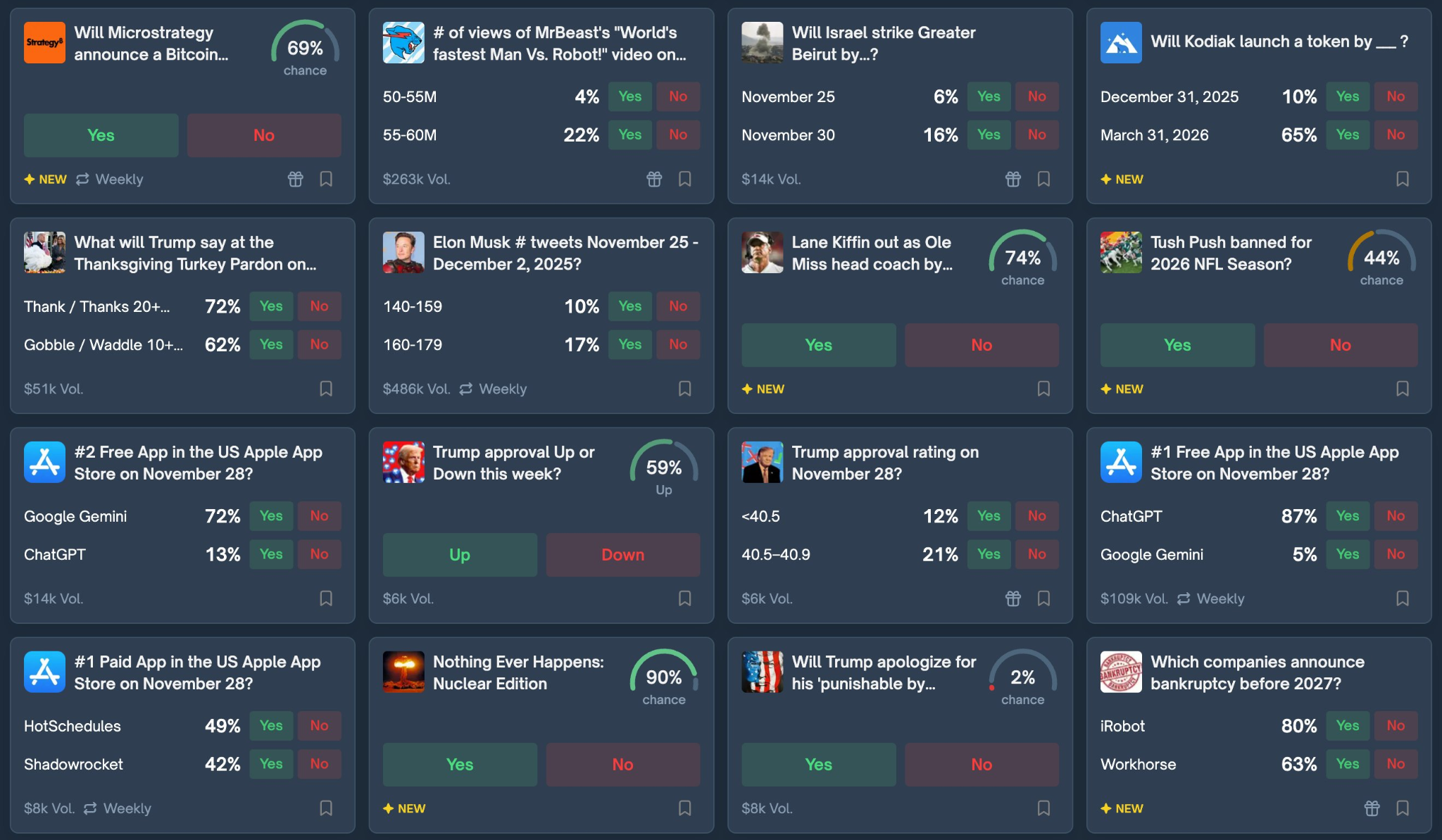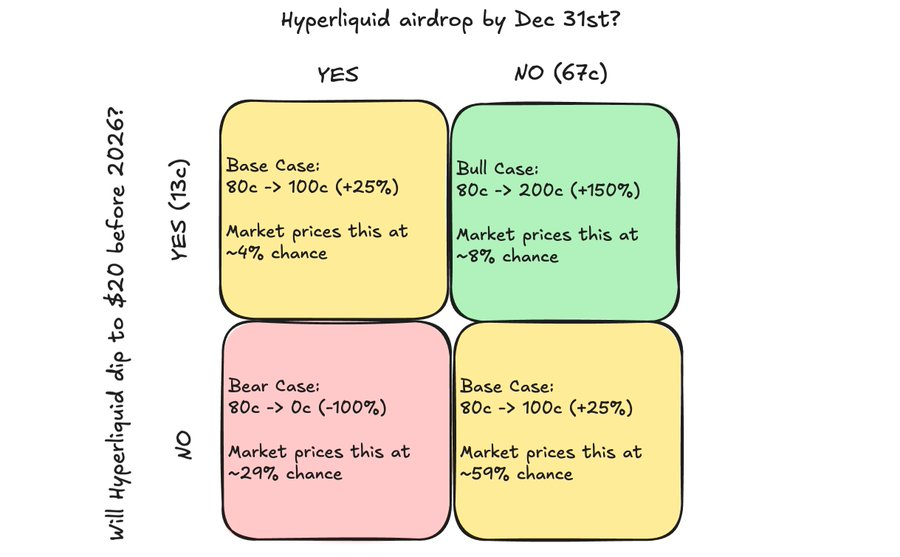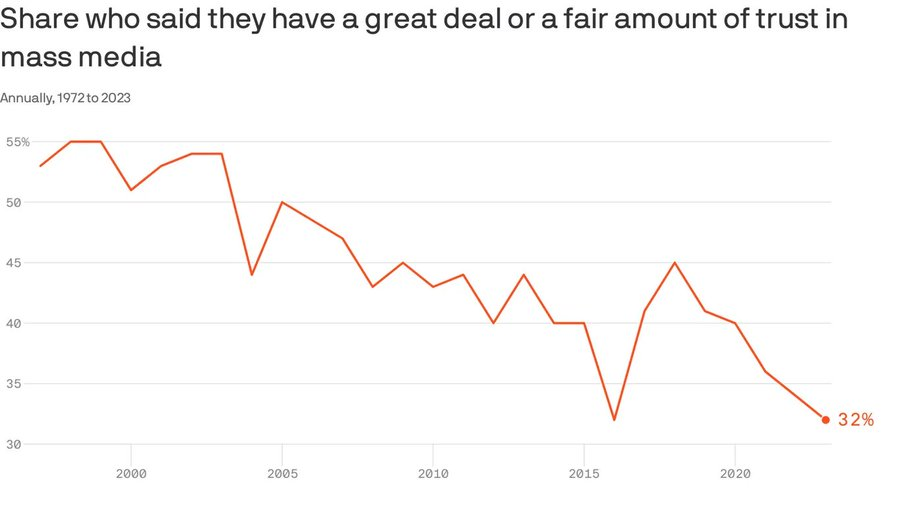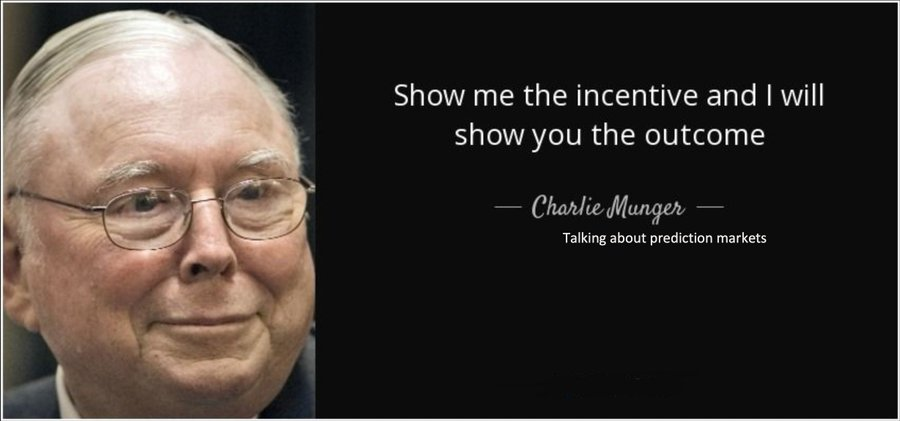Predicting Market Evolution: The iPhone Era is Coming Again
Author | @0xTulipKing
Compiled by Odaily Planet Daily ( @OdailyChina )
Translator | Dingdang ( @XiaMiPP )

Prediction markets are not yet fully understood, and that's where your opportunity lies. We are witnessing a complete restructuring of market structures, how information is priced, and even how the future will be shaped. If you haven't started paying attention now, you'll miss out on the biggest trades in the market since electronic options trading began.
iPhone Moment
Every technological revolution goes through a wonderful phase: people don't see the disruption because they're still using old mental models to understand the new thing. In 2007, a Nokia executive looked at the iPhone and said, "It doesn't even have a keyboard." They were comparing it to a phone, not a computer. The iPhone wasn't competing with existing phones—it was replacing the concept of a "single-function device."
Prediction markets are currently at exactly the same juncture. Many people see Polymarket and simply think of it as a strange, illiquid betting site. They compare it to DraftKings' sports betting or CME's derivatives market and conclude that it "doesn't work." They are repeating Nokia's mistake. Polymarket is not a "better betting site"—it is replacing the very concept of a "professional financial market." Think about what financial instruments are actually like when you strip away all the complexity:
- Options : Betting on whether the price will reach a certain level (YES/NO)
- Insurance : Betting on whether a disaster will occur (YES / NO)
- Credit Default Swaps : Betting on whether a company will go bankrupt (YES/NO)
- Sports Betting : Betting on the outcome of sports events (YES / NO)
We have built trillion-dollar industries for these things that are essentially “binary problems,” each with its own infrastructure, regulatory system, and monopolistic intermediaries, and each layer takes a cut of the profits.

Polymarket simplifies it all to one fundamental element: creating markets around any observable event, allowing people to trade, and then settling accounts when reality provides the answers. It's not a better sports betting platform than DraftKings, nor a better derivatives platform than CME; it does something more fundamental— simplifying all markets to their most basic units and then rebuilding them from there.
Polymarket is like the iPhone; everything else is just an app.
Multi-dimensional trading methods
When all trading takes place in one venue, new possibilities are unlocked. Imagine five years ago you wanted to express this view: "I think the Fed will raise rates, but tech stocks will still rise because Trump might tweet something positive about AI." You would need different accounts at different institutions, facing different regulatory frameworks, and using different leverage tools. Moreover, there simply wasn't a tradable market for the dimension of "whether Trump mentions AI."
On Polymarket, this can be done with just three clicks. More importantly, it's not three isolated bets, but rather a complete worldview expressed through interconnected positions : Buy NO "The Fed pauses rate hikes," Buy YES "The Nasdaq hits a new high," Buy YES "Trump will mention AI in his next speech." Correlation itself is the key to trading.

This is how you should view prediction markets. Here's a real-world example. Last month, on Polymarket, you could construct a portfolio like this:
- Buy NO "Hyperliquid will be airdropped before December 31" at $0.67;
- At the same time, I bought YES "Hyperliquid will fall to $20 by 2026" at $0.13.
Consider this result matrix:
- Your biggest takeaway is that Hyperliquid didn't do any airdrops this year, yet its price still dropped to $20. Considering the current market conditions, this doesn't seem unreasonable; its pricing should be higher than the current 8% market yield. You bought a result you believed in at a low price.
- You will make a small profit : either Hyperliquid will airdrop, causing the price to drop to $20; or the price will drop to $20 without an airdrop. These two scenarios have the highest probability of occurring, at 63%.
- If Hyperliquid airdrops and the price stays above $20, you'll lose everything. Given the market's intense focus on the new supply from team unlocks, an airdrop further increasing market supply seems likely to face strong opposition. The probability of this happening is probably less than 29%, so you're selling at a high price for what you consider an unreasonable possibility.
This sounds like hedging risk, but it's much more than that. It expresses a complex view of how the market handles new token supply, a view that simply cannot be expressed elsewhere.
Traditional markets force you to compress complex worldviews into crude directional bets. You might have a sophisticated theory that Nvidia will significantly exceed expectations, but the stock price might fall because market expectations have already been priced in. In the options market, you can only choose between a call or a put, or construct a clumsy spread strategy to barely express your opinion, but at the cost of a huge premium. In Polymarket, however, you can accurately express your viewpoint simply by buying the options "Nvidia earnings exceed expectations" and "Nvidia stock price drops 5% after earnings release."
Exotic correlations across markets
The real trick lies in focusing on seemingly unrelated yet interconnected events. For example, Florida is about to be hit by a hurricane, while the Buccaneers are playing in Detroit. Conventional logic considers them unrelated, but you make an assumption: if the hurricane does hit Florida, the NFL referees will likely favor the Buccaneers, creating a compelling narrative. So, you bet on the Buccaneers winning and lose, with odds of 60 cents; you bet on the hurricane hitting Florida and win, with odds of 20 cents. You're not betting on the outcome, but on the interconnectedness. You profit by understanding how narratives influence referee decisions.
That's why I say prediction markets aren't competing with existing markets—they operate at a completely different level of abstraction. Traditional markets give you one lever; polymarkets give you countless. More importantly, they allow you to choose specific combinations of options based on your understanding of how the world works.
Why did the "expert" make a mistake again?
The first criticism you hear about prediction markets is always about liquidity. "Oh, you can't really trade." "The spreads are too big." "It's just gamblers gambling with their lunch money." But that's not the loophole—that's your opportunity.

Let's examine the mechanisms behind the impending liquidity explosion. Traditional market making is relatively simple because there are clear relationships between commodities: stock options correspond to stock prices, futures correspond to spot prices, the models are clear, and the correlations are explicit. Therefore, giants like Citadel and Jane Street can make market-making deals for tens of thousands of contracts.
Predicting markets is entirely different; each type of market requires its own specialized intelligent model.
- The sports market needs models that can be updated with every score, every injury report, and every weather change.
- The political market needs natural language processing technology to analyze opinion polls, speeches, and social media sentiment.
- Event markets need machine learning systems that can calculate benchmark interest rates based on historical data.
- The “mention” category market requires a language model trained on thousands of text records.
A single market maker cannot dominate all markets because different sectors require entirely different expertise.
In the long run, this actually benefits liquidity. We will no longer see a few giants monopolizing all market making, but rather an explosive growth in professional market makers. Some teams focus on "market mentions," some on weather-related events, and some on celebrity behavior. This apparent fragmentation will actually lead to a deeper and more stable liquidity structure.
In the next five years, a completely new type of financial institution will emerge: market makers specializing in prediction markets . They don't deal in stocks or bonds; they trade "reality itself." The first company to truly master this technology on a large scale will become Citadel, the new financial system.
About the truth, a disturbing truth.
Now for something truly important: market prediction isn't about prediction itself, but about creating an economic incentive that encourages truth. We live in an absurd age: everyone has an opinion on everything, but almost no one has to take any risk for those opinions. Your favorite Twitter analyst predicted 12 recessions, but only two actually happened; CNBC commentators have been suspended countless times, yet they continue to appear on the show. They keep making mistakes, but without any consequences.

This model is unsustainable, and we all know that deep down. The information systems we've built reward engagement, not accuracy ; volume matters more than accuracy. Social media has exacerbated the problem—today, the most popular opinions prevail, regardless of their factual accuracy. The person with the most followers becomes the expert, and the definition of an expert has become the thing with the most likes.
Prediction markets have completely upended this. Suddenly, predicting correctly comes at a price, and predicting incorrectly also comes at a price. The market doesn't care if you graduated from Harvard, have a verified account, or have written books on markets. It only cares whether your predictions are correct. When you build a system that only rewards accuracy, something amazing happens: those who predict correctly suddenly have a reason to speak, while those who predict incorrectly finally have a reason to shut up.
But this is not simply a matter of transferring wealth from those who should not have it to those who should. Prediction markets are building a parallel information system whose operating mechanism is drastically different from our current media ecosystem.
In the old world: information spread via social networks through "viral" propagation.
In prediction markets: information is priced according to "reality".
These two screening mechanisms are completely different, and the results will naturally be completely different as well.

Although Polymarket is still in a relatively early stage, it has already demonstrated astonishing accuracy.
We've witnessed this in real time on Polymarket: political markets are more predictive than any poll aggregator; Fed-related markets often fluctuate before economists update their forecasts; and earnings markets reflect results in prices weeks in advance, information that doesn't appear in analyst reports for a long time. This isn't because traders are smarter, but because their incentive is to "make sure the predictions are right," not to chase hype.
It's no longer a "prediction market," but a "bounty market."
Now things are starting to get really weird, and this is a key dynamic that I think most people are completely ignoring. We still call them “prediction markets,” but that’s like calling Bitcoin “digital gold”—technically correct, but missing something more fundamental. True prediction markets are passive observers; they price probabilities but don’t change the outcome. A weather futures market doesn’t change the weather itself. But a polymarket isn’t passive, and that’s the key: as long as there are human participants in the market, it inherently contains an “implicit bounty” mechanism for changing the outcome.
Let me be more specific. When there's a market betting on whether someone will throw a green object during a WNBA game, someone calculates it like this:
- Buy $10,000 worth of YES for $1.50
- Throwing objects by oneself
- He received $66,000 when the market settled YES.
- After deducting legal fees and a lifetime ban, the net profit was approximately $50,000.
The equilibrium dynamics presented here are extremely intriguing. Theoretically, this "bounty for disrupting the WNBA" should automatically settle at an equilibrium point:
Benefits = Criminal costs + Social humiliation + Lifetime ban + Required effort
If prices are too high, imitators will emerge; if prices are too low, no one will act. The market will find the perfect balance that drives behavior.

The so-called "prediction market" has now become a bounty market— it's no longer about predicting whether something will happen, but about offering a specific amount of money to incentivize someone to make it happen. This isn't a loophole or manipulation, but rather the most fundamental, yet rarely discussed, characteristic of prediction markets.
Imagine a thought experiment: I decide to run for mayor of New York City. The market gives me a 0.5% chance of winning. At this odds, I can use $100,000 to buy 20 contracts worth $5,000 each. If I win, each contract will pay $1 million.
What's even more interesting is when I offered these contracts as compensation to the campaign team. I hired 20 people and promised each of them $1 million if we ultimately won.
I've just created something that shouldn't exist in reality: a market-funded political campaign, and the lower the odds of winning, the higher my leverage. The market is essentially saying, "This outcome is too unlikely, so we're willing to give you 20 times the odds to try your luck." Prediction has become a bounty. The market is no longer just observing reality, but funding certain versions of the future.
Some events are virtually unaffected by bounty mechanisms—such as becoming president, which is already extremely valuable, and the additional incentive from prediction markets is negligible. But for thousands of other events—from corporate decisions to cultural phenomena to sporting outcomes—bounty mechanisms are real and active.
What we end up with is not the "future politics based on market wisdom governance" envisioned by Robin Hanson, but something much stranger: a market system that pays people to make a certain future a reality.
in conclusion
My prediction is that within ten years, the Polymarket model will devour most of the traditional financial system. The reason isn't lower fees or a better experience, but rather that compressing all markets into a single primitive and rebuilding from the ground up is far more efficient than maintaining countless specialized market structures.
The dominoes will fall in the following order:
- DraftKings – Sports betting is essentially just a prediction market with lower odds.
- CBOE – Options are essentially complex binary bets on price levels.
- Insurance – is simply a market prediction tool that allows you to go long.
- The credit market is essentially about pricing the probability of bankruptcy, only with a few more layers of structure.
These industries will resist, be regulated, and eventually have to yield, because sooner or later they will realize that they are not facing a better product, but a better set of physical rules.
What we are truly witnessing now is a complete restructuring of how markets operate. You are no longer betting on prices, interest rates, or volatility, but on events, the correlations between events, and most importantly, changing the probability of events occurring.
Smart money should start positioning itself now—not just by buying tokens or trading, but by thinking: What happens when every observable event has a liquid market? What if every corporate decision has a market? What if every bill has odds? What if every cultural trend has a price? Can entrepreneurs raise funds by selling "low-probability success shares"? Can anyone with faith in the future directly translate that faith into leverage?
We are building not just better markets, we are building a mechanism that can inspire people to create the future.
- 核心观点:预测市场将重构金融市场底层逻辑。
- 关键要素:
- 简化金融工具为二元事件市场。
- 支持多维事件组合交易策略。
- 建立基于准确性的信息定价机制。
- 市场影响:将颠覆传统金融和博彩行业格局。
- 时效性标注:长期影响



